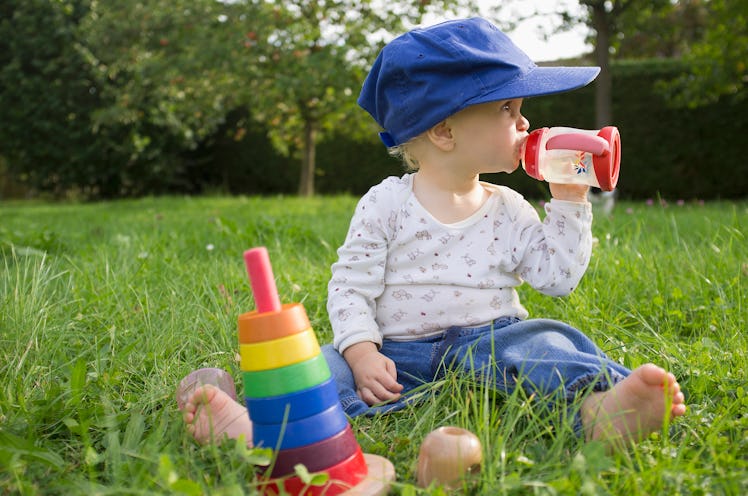Are Sippy Cups Bad For Kids? Experts Weigh In.
In moderation, sippy cups can be powerful tools that teach children independence and keep them hydrated. But there is some developmental risk.

Baby sippy cups can prevent spills, sure. But for every sticky crisis averted, there’s the question of whether the sippy cup was worth it. Many parents worry that sippy cups pose a threat to their child’s development, and there is a basis to this concern. So when should you introduce a sippy cup? Is a cup with a straw developmentally appropriate? Which sippy cups are best for babies versus toddlers? Are sippy cups bad for teeth? Are sippy cups just bad overall? The results are in, and baby sippy cups may not be dangerous — if used in moderation. But over-reliance can lead to very real problems with a kid’s dental health, speech development, and eating habits.
When to Introduce the Sippy Cup
The American Academy of Pediatric Dentistry recommends transitioning away from the bottle when an infant is a year old. The reasoning behind this is to prevent tooth decay that can occur when children’s teeth are exposed to milk sugars for long periods of time. This is when baby sippy cups tend to become part of the equation.
“Dentists, pediatricians, speech therapists, and occupational therapists all agree that sippy cups serve more to keep parents’ floors clean than as an actual necessary part of child development,” says Melissa Foster, a pediatric occupational therapist in Arkansas. “I would caution parents to the overuse of sippy cups, and weigh the benefits of independence over the real risks of cavities, speech delays, and sabotaging meal times.”
Are Sippy Cups Bad for Kids?
The problem here is two-fold: Sippy cups allow on-demand access to calorie-laden beverages like juice and milk, which dampen a child’s appetite by throwing off their feeding patterns. And, more to the point, baby sippy cups promote immature sucking patterns that are appropriate for the bottle or breast, but not for speech development. (In addition, sippy cups send about 2,200 toddlers per year to emergency rooms annually, largely due to injuries suffered after falling with the lids in their mouths.)
“Appropriate use of a sippy cup is at mealtime, or drinking water between meals, when the child picks up the cup, drinks, sets it down, and goes about their business,” Amy Delaney, Ph.D., a speech pathologist at the Children’s Hospital of Wisconsin, told Fatherly. “It’s like anything in development. In moderation, most anything is okay.”
It’s rumored that speech pathologists, too, dislike sippy cups. As they grow older, children are supposed to transition from using the suckling reflex to drink to using a more mature suckling pattern, in which the tongue retracts and lips tighten. Sippy cups allow the tongue to remain lazy, the argument goes, and the lips to remain loose.
Delaney doesn’t buy it. She says that it’s actually “very rare that children suck on a sippy cup with the same pattern as a pacifier or thumb.” Still, she does worry about overuse and dental consequences because sucking and gnawing can affect tooth alignment.
There are some potential benefits to using a baby sippy cup. Sippy cups can keep children hydrated in a spill-proof fashion, without requiring an enormous amount of clean-up. They can help kids understand their own thirst. And they can be part of a variety of different cups parents use to help children understand different situations or to simply develop drinking skills.
“I like to very gently expose infants to different vessels at an earlier age,” Foster says. “This can be from a sippy cup, open cup, straw cup, spoon, or simply taking drops from the end of a straw held from Mom’s glass of ice water. This is simply to broaden the infant’s sensory experiences.”
When to Use a Baby Sippy Cup or an Alternative
The American Speech-Language-Hearing Association recommends that parents introduce a pop-up straw cup as children transition to using normal adult cups. This way, kids don’t spill, and it minimizes the risk of dental problems. Some pediatricians favor using sippy cups during mealtimes only and never allowing them to become comfort objects. The limited scientific literature on the subject says sippy cups are fine if parents are in control of their use, which is a lot easier to do during meals.
The use of sippy cups remains precisely the sort of topic that parents love to debate. But as with most things, moderation is key, and the stakes remain low. “It’s a hot topic. But in general, it’s a transient mode of drinking for most kids,” Delaney says. “What it comes down to is how it’s being used, and the persistent nature of it. There are millions of children that drink sippy cups and have no problems at all.”
The Best Sippy Cups for Dental Health: A Cheat Sheet
- Kids will drink more out of sippy cups — which can be a problem when they’re filled with sugary drinks like milk or juice.
- When on the go, sippy cups with straws make a lot of practical sense. Go ahead, use them.
- When at home, think twice about offering the sippy cup. If a kid can make do with another vessel, it’s good to mix it up.
- It’s not necessarily about speech. New kinds of drinking vessels give toddlers new sensory experiences. This is good for them.
This article was originally published on